| |
◎
An
Introduction to the Sutras and Dharma Instruments
│1│2│3│4│ |
|
(1)Dharma
Instruments Used in Making Offerings to the Buddhas and Bodhisattvas
The most commonly used Dharma instruments in making offerings to the
Buddhas and Bodhisattvas are incense burner, flower vase, and candlestick.
However, depending on their placements and numbers, there can be different
arrangements, known as the three essential articles of offering, the four
essential articles of offering, and the five complete articles of offering.
If we place one incense burner, one flower vase, and one candlestick
in front of the Buddha image, we are using the arrangement of the “three
essential instruments of offering.” Although this particular placement
has its origin in China, the articles used are of Indian tradition.
The arrangement of the “four essential instruments of offering” consists
of two flower vases, one incense burner, and one candlestick placed in
front of the Buddha image. This placement originated from the Japanese
Heian Period (late 8th century to late 12th century).
The arrangement of the “five complete instruments of offering” consists
of two flower vases, two candlesticks, and an incense burner placed in
front of the Buddha image and has its origin in the Japanese Kamakura
Period (late 12th century to 14th century).
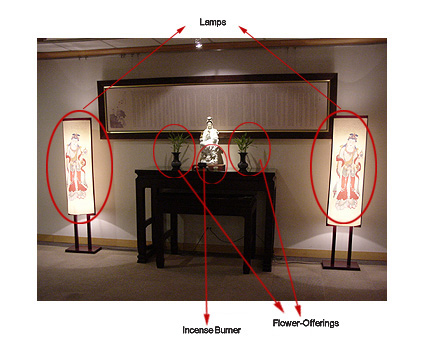 |
| The Five Complete Instruments of
Offering/Model Buddhist Sanctuary, Fo Guang Yuan Art Gallery, Taipei,
Taiwan |
(2)Dharma Instruments
Used in Buddhist Chanting and Recitation
Dharma instruments used
in Buddhist chanting and recitation include the big bell-bowl, the wooden
fish, the wooden fish board, the bronze cloud plate, the bell, and the
drum. They are usually struck during a temple's daily activities, assemblies,
chanting sessions, and Dharma services.
◎The Big Bell-bowl
The bowl-shape instrument in the picture
below is called the big bell-bowl. It is struck during Dharma services,
morning and evening chanting by the leading monastic using a wooden stick
to guide the assembly in changes in tempo or movements of the chanting
in progress. It is placed on the right-hand side of the offering table.
◎The
Wooden Fish
The wooden fish is the Dharma instrument on the left-hand
side of the offering table. In chanting a sutra, the assembly will follow
the rhythmic beat of the wooden fish to create a sound of resonance and
order.
Why
is it shaped like a fish? It is because the eyes of a fish never close;
they are always open, swimming or resting, day or night. Precisely, it
is this characteristic of the fish that is used to remind the monastics
to always be diligent and heedful in their cultivation.
◎The
Wooden Fish Board
This high-hanging big fish, or the wooden
fish board, is a very important instrument of the temple because it is
used to inform the masses of mealtime. When it is struck, everybody needs
to get in line and enter the dining hall in an orderly manner to take
his/her seat. It is also called the meal board since it is usually hung
in the hallway of a dining hall to inform everyone that it is time to
eat.
◎The
Bronze Cloud Plate
The bronze cloud plate, opposite of the
wooden fish board, is shaped like a cloud. It is struck by a designated
server after everyone has taken his/her seat to inform the assembly that
they can start eating their meals after striking the bronze cloud plate
is done.
◎The
Big Bell
The big bell is used in a temple as an instrument of
time and a signal for everyone to assemble. When it is struck early in
the morning, waves of resonant sound will issue forth, across the horizon,
not only to awaken those who are deluded by dreams of illusion, but also
to remind them to be heedful of the passage of time, to be diligent in
their cultivation, and to make good use of every day.
◎The
Drum
The drum, one of the most used Dharma instruments of the temple,
serves to awaken the masses. As the night falls, the deep sound of the
drum signifies the end of a workday, and at the same time, tells us that
rest is necessary for a long journey ahead. We should be diligent in our
progress because the end of one day is just the beginning of another.
In
a temple, the drum is placed opposite of the big bell, in front of the
main shrine, thus acquiring the name “right drum and left bell.” They
are also known as the “morning bell and evening drum” because in a temple,
the bell is struck before the drum in the morning and vice versa in the
evening.
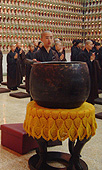 |
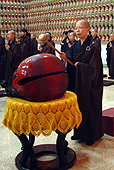 |
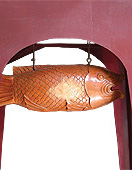 |
 |
| The karmadana (the leading monastic)
strikes the big bell-bowl to lead the assembly in their chanting and
recitation./Students of Fo Guang Shan Monastic College |
By striking the wooden fish, the
sounds of chanting are harmonious in their unity./Students of Fo Guang
Shan Monastic College |
On hearing the sound of the wooden
fish board, one can enter the dining hall and get ready for meal./The
wooden fish board at the dining hall of the Cloud Dwelling Building,
Fo Guang Shan Monastery, Kaohsiung, Taiwan |
After entering the dining hall, the
sound of the bronze cloud plate tells the assembly that it is almost
time to eat./The bronze cloud plate at the dining hall of the Cloud
Dwelling Building, Fo Guang Shan Monastery, Kaohsiung, Taiwan |
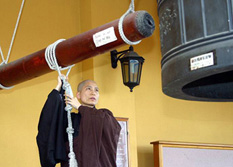 |
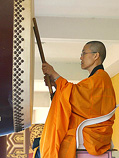 |
| The sounds of the big bell can transcend
all obstacles to drift freely across the sky to awaken all sentient
beings./Nan Tien Temple, Australia |
The sounds of the drum are like thunder
and lightning, pounding rain and driving wind, to symbolize peace
and prosperity, favorable weather and good crops./Nan Tien Temple,
Australia |
|
|











